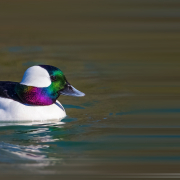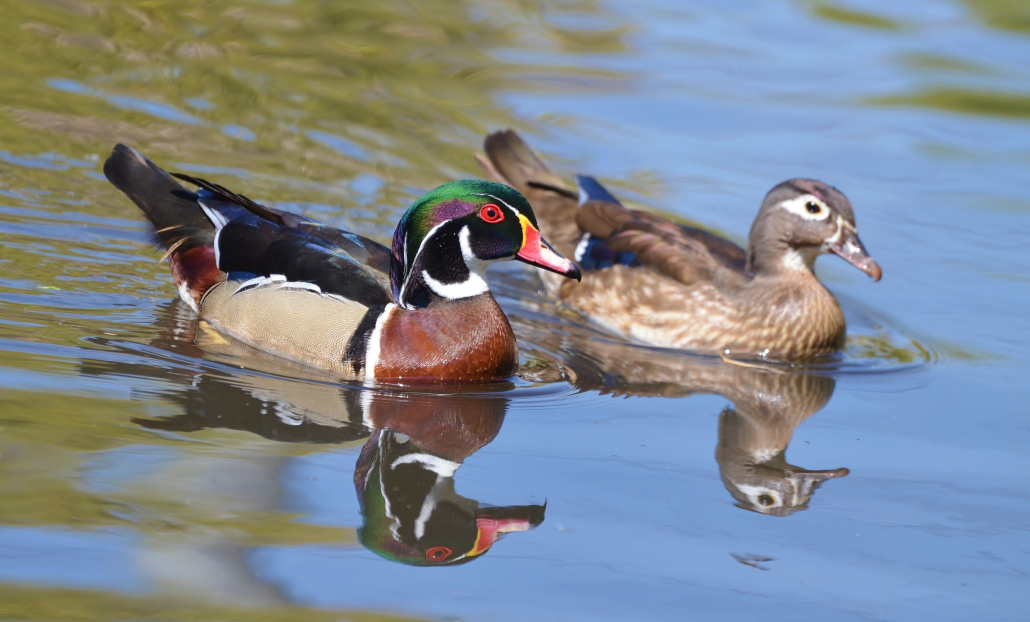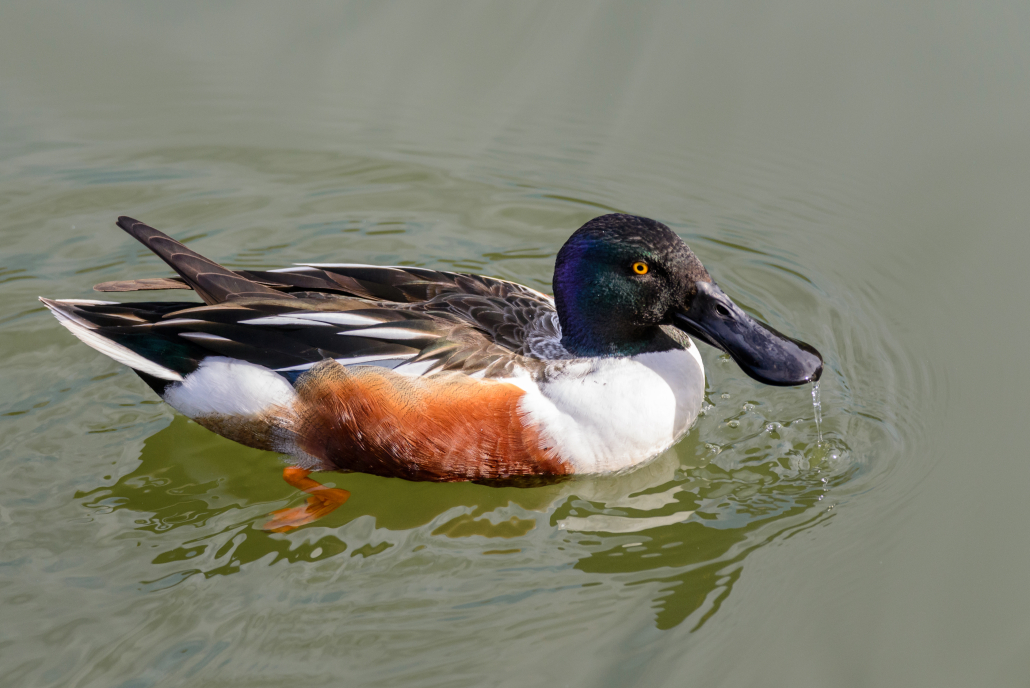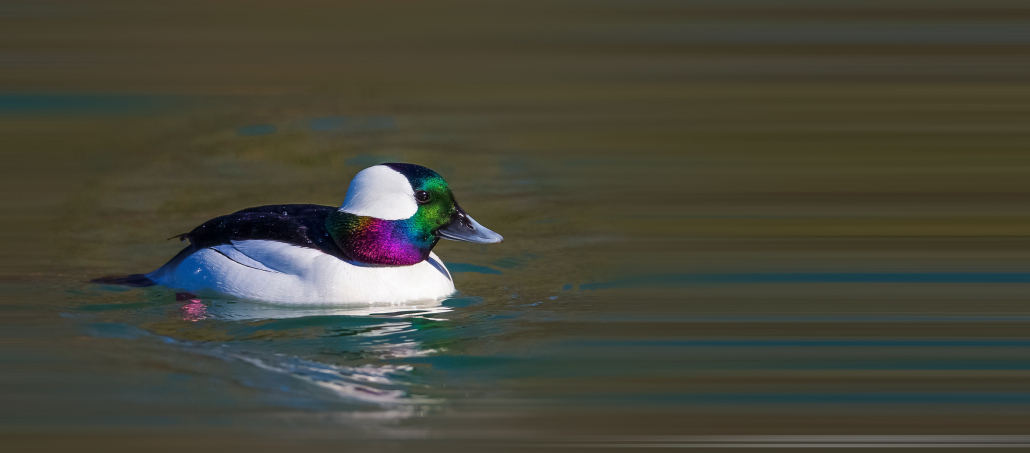If It Walks Like A Duck
While walking around Lake Clara Meer, you’ve probably noticed ducks either swimming in the lake or hanging out on its banks. Have you ever wondered about the different types of ducks that inhabit the park and when during the year you can find them here?
In fact, more than 10 different types of ducks can be found in Piedmont Park, few of which actually have the word duck in their name. Listed below are the formal names of ducks you can see during your visit to the park along with descriptive information about each type. After the duck’s name is the time of year that each has been observed here.
Muscovy Duck (year-round)
With their long necks, heavy bodies, webbed feet and spatula-shaped bills, these birds are instantly recognizable as ducks but there are many clues that help Muscovy ducks stand out from the flock. Their relatively long bill is dark at the base with variable color bands along its length, including white, pale blue-white, and pink, and the nail at the bill’s tip is gray. Even though the word Muscovy means “from Moscow”, these ducks are not from Moscow.
Ruddy Duck (January)
The ruddy duck is a species of stifftail duck (others include the masked duck and blue-billed duck) and is a diving duck with a spiky stiff tail which is used as a rudder while swimming. The tail may also be held angled or vertically as a breeding or territorial display especially between competing males. These ducks often have colorful bills and compact bodies.
Ring-necked Duck (November through April)
The ring-necked duck is a small to medium-sized diving duck that has two white rings surrounding its gray bill, a shiny black angular head, black back, white line on its wings, a white breast and yellow eyes. The female has a grayish brown angular head and body with a dark brown back, a dark bill with a more subtle light band than the male, grayish-blue feet and brown eyes with white rings surrounding them. This duck is sometimes referred to as a ringbill.
Wood Duck (year-round)
The wood duck or Carolina duck is one of the most colorful North American waterfowl. Breeding males exhibit ornate, colorful patterns visible up-close but appear dark overall at a distance; females are gray-brown with a thin white ring around the eye. The wood duck possesses a crest on its head and flies through trees with exceptional maneuverability thanks to its long tail. Often shy and quick, the wood duck’s call is a loud, screeching whistle.
Mallard (year-round)
Mallards are large ducks with hefty bodies, rounded heads and wide, flat bills. The mallard’s body is long and the tail rides high out of the water, giving a blunt shape. Male mallards have a dark, iridescent-green head and bright yellow bill. The gray body is sandwiched between a brown breast and black rear. Females and juveniles are brown with orange-and-brown bills. Both sexes have a white-bordered, blue patch on their wings.
Redhead (March)
The redhead goes by many names including the red-headed duck and is easily distinguished from other ducks by the male’s copper-colored head and bright blue bill during the breeding season. Slightly larger than a ring-necked duck and slightly smaller than a canvasback, the redhead is a medium-sized diving duck with a smoothly rounded head and a moderately large bill. Redheads have black-tipped, gray bills, and in flight they show gray flight feathers.
Canvasback (December & January)
The canvasback is the largest species of diving duck in North America measuring up to 22 inches in length and weighing up to 3.5 pounds. The canvasback has a distinctive wedge-shaped head and long graceful neck. Its sloping profile distinguishes it from other ducks. Both male and female have a black bill; the male has a chestnut red head and neck while the female has a light brown head and neck. The canvasback’s legs and feet are bluish-gray.
Northern Shoveler (Spring & Fall)
Appropriately nicknamed the spoonbill, the northern shoveler has the largest bill of any duck in North America. The bill is actually longer than the duck’s head with a flattened wide tip perfect for “shoveling” along the water’s surface for food. Males have an iridescent green head; females are brown, buff and black with darker upperparts, finer streaking on the head and a faint dark eye line. Both genders have yellow eyes, and bright orange legs and feet.
Blue-winged Teal (Spring & Fall)
There are more than 20 species of teal ducks throughout the world. The blue-winged teal is a smaller, petite duck characterized by its short neck and short tail. Males have brightly marked, distinctive plumage. The unexpected shades may be difficult to see when the bird’s wings are folded but very colorful when in flight. Females are more camouflaged with muted, earth tone colors which serve as protection while they are nesting or caring for young ducklings.
Lesser Scaup (January & March)
The lesser scaup is a medium-sized diving duck, smaller than the closely-related greater scaup, with a small peak at the back of the head. It is colloquially known as the little bluebill or broadbill because of its distinctive blue bill. The lesser scaup is one of the most numerous and widespread diving ducks in North America. Its name, scaup, may stem from the bird’s preference for feeding on scalp—the Scottish word for clams, oysters and mussels.
Bufflehead (February through April)
Adult males are striking black and white with iridescent green and purple heads and a large white patch behind the eye. Females are gray-toned with a smaller white patch behind the eye and a light underside. The bufflehead rivals the green-winged teal as the smallest American duck, measuring under 16 inches long and weighing under 20 oz. Its name refers to its head shape, noticeable when the male puffs out the feathers on its head, greatly increasing its size.
Hooded Merganser (November & December)
The most prominent feature of this small, slim, streamlined duck is its narrow, serrated, hooked bill. The merganser is the only type of duck that regularly eats a large amount of fish and similar prey, and its bill is specialized to make this duck a keen and ferocious hunter. Two other species of this duck includes the common and the red-breasted merganser.
Piedmont Park Ducks – Do’s & Don’ts
Do’s
- Only offer foods in bite-sized pieces the ducks can easily consume without choking or struggling.
- Good foods for ducks include bite-sized pieces of apples and tomatoes, cracked corn, chopped kale, bite-sized pieces of romaine lettuce or Swiss chard and watermelon
- Enjoy the experience of being in nature with these colorful birds
Don’ts
- Don’t feed bread to the ducks; it’s not good for them
- Do not allow pets or children to chase or disturb the ducks
- Stop feeding if the ducks appear uninterested or are leaving the food uneaten, and avoid feeding the ducks if other visitors are already offering treats
Guest Post by Don Disner
AUTHOR’S BIO: Don Disner






